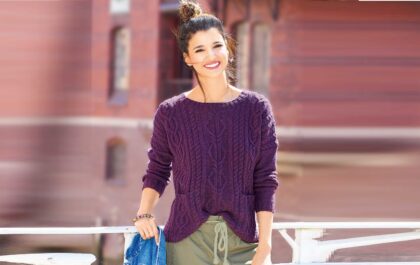
Long dress with cones. Elegant, chic floor-length dress. Crocheted from individual motifs.

You will need: 650 g of Ibiza Yarn Art yarn (60% viscose, 40% acrylic 550m 100g): almost 400g for the bottom consisting of motifs, 100g for the top/t-shirt, approximately 150g for the border - hook number 3.
Note 1: if you knit cones from 5 stitches and/or with 1 crochet, then you need less yarn.
Note 2: yarn consumption and all dimensions and calculations are given for size 42 and height 168 cm.
Note 3: It is wise to use different size hooks. Crochet the upper part and the motifs at the waist with crochet No. 2, then switch to hook No. 2.5 and finish the bottom with crochet No. 3. Then the top of the dress will not look too stretched compared to the bottom.

Part of motives: We begin the work with a part consisting of motives. Scheme of the complete motif (see Fig. 2). To smoothly expand the skirt towards the bottom, the following technique is used: at the top of the skirt, the motifs are not fully knitted - until the second or even the first row of cones; below, the sizes of the motifs gradually increase and only the lowest motifs are full.

See how the motifs are distributed along the rows in the catwalk model, in Lelu and in another version in (Fig. 4). We knit 8 motifs of 2 cones (motifs that end with the second row of cones) and close them into a ring. At the same time, we form a smooth edge at the top of the skirt by attaching 4 half-motifs of 2-pieces (see Fig. 5)
The diagram of the half motif is shown in (Fig. 3.) Then we knit according to the selected distribution of rows. How to connect motifs is shown in (Fig. 6.)

Fig 6 - Connecting motifs. We pull the hook out of the loop and thread it into the loop of the motif with which we connect. We pick up the loop that was dropped. Pull out the loop and continue knitting the motif as usual. When transitioning from one motif to another, there is no need to break the thread: the motifs are quite dense, and on the front side these transitions will not be visible in the finished product. (Fig. 7) shows how you can economically move from one motif to another.

Fig 7 - An economical method of joining motifs so that the sections of thread on the wrong side are as small as possible and there is no need to cut the thread repeatedly. In the last row, you need to make sure that the last knitted vertex of the motif is in the right place. If we look at the example of the 1st motif of the 2nd row, then in the last row you need to knit 2 ribs, then the 3rd, 4th and 5th ribs are attached to existing motifs, and the 6th rib is not attached to anything, and then the 6th vertex is in the right place in order to continue knitting the next motif.



Related posts
About the Author

Welcome !
My name is Lilia. The main hobby of my life is knitting. I started with knitting needles and switched to a knitting machine. In 1988 I got acquainted with crochet - Romanian lace. About 10 years ago I became interested in Irish lace and Shetland knitting. And now I’m trying fillet crochet. On this site I want to share with you my 45 years of experience in various knitting techniques.
Latest publications
Пуловер с узором из снятых петель, шарф в полоску и шапка с помпоном
Jacquard pullover
Лиловый джемпер с узором из «кос»
Пуловер AZIMUTH
Fading Circles Jumper
Blog Subscription
Be the first to receive new items!



